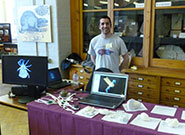CT scanning and 3D printing allow palaeontologists to see fossils in ways they never could before, to study delicate bones and other ancient remains in great detail without destroying the precious specimens themselves. Now Dr Imran Rahman of Bristol's School of Earth Sciences and colleagues aim to bring such 'virtual palaeontology' to the wider public.
Dr Rahman said: "Fossils provide us with the only direct evidence of prehistoric life. Without them we would know next to nothing about such fascinating extinct creatures as dinosaurs, trilobites and woolly mammoths. While most fossils are flattened, two-dimensional specimens, sometimes, under unusual circumstances, fossils can be three-dimensionally preserved.
"Such 3D fossils provide scientists with an unparalleled opportunity to reconstruct the biology and evolution of extinct creatures. Owing to their spectacular appearance, these fossils are also ideal tools for educating non-specialists in palaeontology. However, the most outstanding specimens are extremely rare and often very fragile and are therefore not generally accessible to the public."
Dr Rahman and colleagues decided to create an educational resource that would allow anyone, not just specialists, to interact with such rare and precious fossil specimens.
Using CT (computed tomography) scanning – an X-ray based scanning technology used widely in hospitals for diagnosing internal injuries and increasingly adopted by palaeontologists to produce cross-section images of specimens – they created digital models of a number of prehistoric invertebrates from well-preserved 3D fossils. Highly detailed and accurate replicas of these original fossils were also created using 3D printing.
The models were then displayed at an event at the Lapworth Museum of Geology in Birmingham earlier this year. Members of the public were able to interact with the computer reconstructions and view them on a screen with 3D glasses. The 3D prints of the fossils were also displayed and visitors were encouraged to handle them. A video described the virtual palaeontology approach and Dr Rahman and fellow researcher Dr Russell Garwood of the University of Manchester were on hand to answer any questions.
The interactivity of the virtual fossils made them highly effective for engaging the public, particularly young people, and the state-of-the-art technologies also appealed to adults who might not normally be interested in fossils.
Dr Rahman said: "The marriage of computer science and the study of past life has created an incredibly exciting field – one which should not be limited to an academic sphere. We believe that with concerted efforts to communicate this work, virtual palaeontology can increase the public understanding of evolution and provide a valuable addition to the biological educator's armoury."
The project, which was funded by the Natural Environment Research Council (NERC), is described in a paper published today in the journal Evolution: Education and Outreach.
Paper
'Virtual Fossils: a New Resource for Science Communication in Paleontology' by Imran A. Rahman, Keith Adcock and Russell J. Garwood in Evolution: Education and Outreach.
